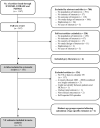Epidemiology and burden of illness of seasonal influenza among the elderly in Japan: A systematic literature review and vaccine effectiveness meta-analysis
- PMID: 32997395
- PMCID: PMC7902263
- DOI: 10.1111/irv.12814
Epidemiology and burden of illness of seasonal influenza among the elderly in Japan: A systematic literature review and vaccine effectiveness meta-analysis
Abstract
Background: Elderly populations are particularly vulnerable to influenza and often require extensive clinical support. In Japan, nationwide passive surveillance monitors seasonal influenza but does not capture the full disease burden. We synthesized existing evidence on the epidemiology, vaccine effectiveness (VE), and economic burden of seasonal influenza in the elderly population.
Methods: PubMed, EMBASE, and ICHUSHI were searched for articles on seasonal influenza in Japan, published between 1997 and 2018, in English or Japanese. Grey literature was also assessed. A random-effects meta-analysis characterized VE of influenza vaccines among studies reporting this information.
Results: Of 1,147 identified articles, 143 met inclusion criteria. Reported incidence rates varied considerably depending on study design, season, study setting and, most importantly, case definition. In nursing homes, the maximum reported attack rate was 55.2% and in the 16 articles reporting mortality rates, case fatality rates varied from 0.009% to 14.3%. Most hospitalizations were in people aged >60; healthcare costs were partially mitigated by vaccine administration. Meta-analysis estimated overall VE of 19.1% (95% CI: 2.3% - 33.0%) with a high proportion of heterogeneity (I2 : 89.1%). There was a trend of lower VE in older people (40.1% [-57.3-77.2] in the <65 group; 12.9% [-8.0-29.8] in those 65; P = .21).
Conclusions: Despite differences between studies that make comparisons challenging, the influenza burden in elderly Japanese is significant. While vaccines are effective, current vaccination programs offer suboptimal protection. Health economic data and cost-effectiveness analyses were limited and represent areas for policy-relevant future research.
Keywords: Japan; economic burden; elderly; epidemiology; meta-analysis; seasonal influenza; systematic literature review; vaccine effectiveness.
© 2020 The Authors. Influenza and Other Respiratory Viruses Published by John Wiley & Sons Ltd.
Conflict of interest statement
Joshua Nealon, Yuriko Hagiwara are employed by Sanofi Pasteur, a company which produces influenza vaccines. Daisuke Tsuzuki and Marwa Klai were working at Sanofi at the time of performing the study.
Figures




References
-
- Azziz Baumgartner E, Dao CN, Nasreen S, et al. Seasonality, timing, and climate drivers of influenza activity worldwide. J Infect Dis. 2012;206(6):838‐846. - PubMed
-
- World Health Organization . Influenza (Seasonal). 2018. https://www.who.int/news-room/fact-sheets/detail/influenza-(seasonal). Accessed 29 July 2019.
-
- Japan Medical Association, The Japanese Academy of Pharmaceutical Science and Technology, School of Pharmacy Nihon University, EM Systems Co., Ltd . Pharmacy surveillance daily report. http://prescription.orca.med.or.jp/syndromic/kanjyasuikei/index.html. Accessed 29 July 2019 (in Japanese).
Publication types
MeSH terms
Substances
LinkOut - more resources
Full Text Sources
Medical
Miscellaneous

